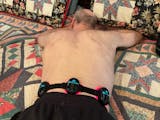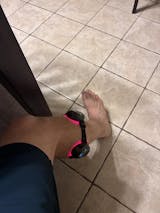How to Get Rid of Stiff Neck in 10 Seconds

If you've ever woken up with a stiff neck or developed neck discomfort throughout the day, you know how annoying it can be. Neck stiffness can be caused by many things, such as poor posture, muscle strain, or stress. While it may seem impossible to relieve it quickly, there are some simple techniques you can try. In this article, we’ll show you how to get rid of a stiff neck in just 10 seconds, including the use of medical-grade red light therapy devices for longer-lasting relief.
Understanding the Causes of a Stiff Neck
Common Triggers of Stiff Neck
Neck stiffness often occurs due to common triggers like poor posture, muscle strain, or sleeping in an awkward position. When the muscles in your neck are stretched or contracted for too long, they can tighten up, leading to discomfort. Identifying what caused the stiffness can help you prevent it from happening in the future.
The Role of Stress in Neck Stiffness
Stress is a major contributor to neck stiffness. When you're stressed, your body tends to tighten up, especially around the neck and shoulders. This muscle tension can lead to discomfort and stiffness that seems impossible to shake. Relaxing your mind and body through techniques like breathing exercises can help ease this tension.
How Poor Posture Affects Your Neck
Poor posture—whether from sitting at a desk for long periods, looking down at your phone, or slumping while standing—puts extra strain on your neck muscles. Over time, this can cause stiffness and even pain. Maintaining good posture throughout the day is key to preventing neck stiffness and pain.

Quick Relief for Stiff Neck
Use Heat or Cold Therapy
One of the fastest ways to relieve a stiff neck is by applying a heat or cold compress. Heat helps to relax tight muscles, while cold can reduce inflammation. You can use a warm towel or heating pad for immediate relief, or try a cold pack if the neck is inflamed. These methods provide quick comfort and ease the tension in your neck.
Gentle Stretches and Neck Movements
Stretching your neck muscles gently can help relieve stiffness quickly. Slowly rotate your neck in a circular motion, first clockwise and then counterclockwise. This movement helps improve circulation to the muscles and can alleviate tightness in just a few seconds. Avoid sudden, jerky motions to prevent further injury.
The Power of Good Posture
Good posture can work wonders for a stiff neck. By simply adjusting your posture, you can instantly reduce strain on the muscles. Stand tall, align your head with your spine, and relax your shoulders. This simple adjustment can instantly alleviate neck stiffness and prevent it from coming back.
How to Use Medical-Grade Red Light Therapy Devices for Neck Relief
What Is Medical-Grade Red Light Therapy
fda approved red light therapy devices for pain use specific wavelengths of light to penetrate the skin and tissues beneath, stimulating cellular repair and reducing inflammation. This therapy helps improve circulation, relaxes tight muscles, and can significantly reduce neck pain and stiffness over time.
Benefits of Red Light Therapy for Neck Pain
FDA approved red light therapy offers a non-invasive, drug-free solution to neck stiffness. By promoting healing at the cellular level, Red light therapy module - PRUNGO FluxGo can provide long-term relief from muscle tension, inflammation, and pain. It's an effective way to address the root causes of stiffness without relying on medication.
How to Use Red Light Therapy for Stiff Neck
Using a red light therapy machine is simple. Place the device on the affected area for a few minutes each day. The light energy will penetrate the skin and target the muscles that are tight and inflamed, helping to relax them and improve circulation. Regular use will provide lasting relief from neck stiffness.

Breathing Techniques to Relax Neck Muscles
Deep Breathing for Immediate Relaxation
Deep breathing can help relieve neck tension almost immediately. Inhale slowly through your nose for a count of four, hold for four, and then exhale slowly through your mouth for a count of four. This exercise helps calm the nervous system and reduces muscle tightness, providing quick relief for a stiff neck.
Diaphragmatic Breathing for Long-Term Relief
Diaphragmatic breathing, also known as abdominal breathing, is a deeper form of breathing that helps to reduce overall muscle tension. By focusing on slow, deep breaths that expand your diaphragm, you help activate the body’s relaxation response, which can reduce neck stiffness over time. Practice this regularly to prevent future tension.
Massage Techniques to Relieve Neck Stiffness
Self-Massage Methods
You can relieve neck stiffness quickly by using your fingers to gently massage the back of your neck, shoulders, and upper back. Apply light pressure to areas that feel tight and move in circular motions. This will help increase blood flow to the muscles and reduce stiffness.
Professional Massage for Chronic Stiffness
If neck stiffness persists, seeing a licensed massage therapist may be necessary. They can perform deeper tissue work that targets chronic muscle tightness and helps release the built-up tension. Regular massage therapy sessions can significantly reduce neck pain and stiffness over time.


Improving Sleep Habits to Prevent Neck Stiffness
Sleep Posture Tips
Your sleep position plays a huge role in whether you wake up with a stiff neck. Try sleeping on your back or side, using a pillow that supports the natural curve of your neck. Avoid sleeping on your stomach, as this can strain the muscles in your neck and lead to stiffness.
Using a Medical-Grade Pillow for Neck Support
Investing in a medical-grade pillow designed specifically for neck support can help you maintain proper posture while you sleep. This type of pillow promotes better alignment of your neck and spine, preventing neck stiffness and pain when you wake up.
Preventing Future Neck Stiffness
Regular Exercise and Neck Strengthening
Strengthening the muscles around your neck and shoulders can help prevent stiffness in the future. Regular exercises that target the neck, upper back, and shoulders can improve flexibility and reduce muscle tightness. A strong neck is less likely to become stiff or painful over time.
Stretching Before and After Physical Activity
Incorporating neck stretches into your routine before and after physical activities can help keep your muscles loose and flexible. Stretching helps improve range of motion, which can reduce the risk of developing a stiff neck after exercise or physical strain.
Ergonomics at Work and Home
Setting up an ergonomic workspace can significantly reduce neck strain. Make sure your computer monitor is at eye level, and that you sit in a chair with good lumbar support. By paying attention to your posture throughout the day, you can prevent future episodes of neck stiffness.
Conclusion
Neck stiffness can be uncomfortable, but there are quick methods to relieve it within 10 seconds. Options like hot or cold therapy, gentle stretching, or using a medical-grade red light therapy device can offer immediate relief. If you're looking to focus on other areas of your body as well, you might want to explore a red light therapy panel or a red light therapy mask for broader relief. To avoid future neck stiffness, consider strengthening your neck muscles and improving your posture.




















0 comments